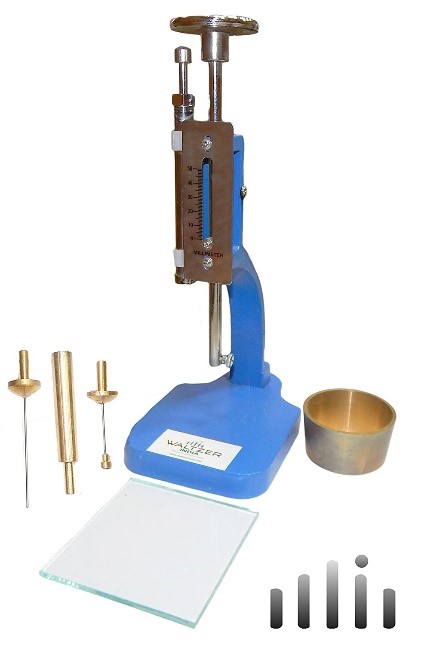What is the use of Vicat’s apparatus?
What is Vicat’s Apparatus?
 Vicat’s Apparatus is extensively used to take out the consistency of cement, initial setting time and final setting time. Vicat’s apparatus has an arrangement that consists of a Vicat plunger (10 mm in diameter), Vicat needles, Vicat mould, gauging trowel, measuring jar (200ml capacity), weighing balance, stopwatch, weight box, glass plates and gloves.
Vicat’s Apparatus is extensively used to take out the consistency of cement, initial setting time and final setting time. Vicat’s apparatus has an arrangement that consists of a Vicat plunger (10 mm in diameter), Vicat needles, Vicat mould, gauging trowel, measuring jar (200ml capacity), weighing balance, stopwatch, weight box, glass plates and gloves.
As shown in the above image, the Vicat apparatus consists of a set having a movable rod with a cap at one end and a removable needle or plunger at the other. The movable rod moves along a vertical indicator graduated in mm from 0 to 40 to measure the vertical movement of the plunger. The rod with cap and needle weighs 300 gm.
A plunger having 10 mm diameter and 50mm long, whose lower end is flat, is used for the consistency test. A needle having a 1 mm square area with lower-end flat is used for initial setting time and the needle used for final setting time is the same as for initial setting time but attached with a metal having 5mm diameter.
Consistency test of Cement:
A consistency test is used to find out the amount of water to be added to the cement to form a cement paste with great workability. The standard consistency of cement allows the Vicat plunger to penetrate the cement paste to a height of 5 to 7mm from the bottom of the Vicat mould.
Procedure:
- In order to prepare a sample in mould, we need to take 400 gm of cement passed through an 850-micron IS sieve.
- Add 100 ml of water to it. While adding water it should be kept in mind that gauging time (time of adding water until we start filling the mould with paste) is between 3-5 minutes.
- Rest the mould on a non-porous plate and fill it with the paste prepared. Tap the mould to remove any bubbles of air.
- Place the mould along with the plate under the rod and plunger attached with the apparatus.
- Lower the plunger gradually till it touches the surface of the mould and then releases it quickly.
- Prepare similar moulds with varying quantities of water and test in a similar way to find standard consistency.
Initial setting time of Cement:
- Prepare a cement paste with 0.85 P amount of water.
- P = Standard consistency found from the above test
- Keep in mind the gauging time of cement.
- Fill out the Vicat mould and finish its surface. A test block is now prepared for the test.
- Again, place the mould on a non-porous plate under the rod and needle.
- Lower the needle to touch the surface and release quickly and let it penetrate through the paste.
- Keep repeating this procedure until the needle fails to penetrate the mould for about 5mm from the bottom of the mould.
- The time has gone since the water was added to the cement until the time when the needle fails to pierce the mould till 5 mm from the bottom is known as Initial Setting Time.
Final setting time of Cement:
- In order to determine the final setting time of the cement paste, we need to replace the needle with the other one having a metal attachment.
- Similarly, the needle is gently lower to touch the surface of the mould and if the needle leaves an impression but the metal attachment doesn’t, then cement paste has finally set.
- Draw a plot between the percentage of water and penetration in mm.






